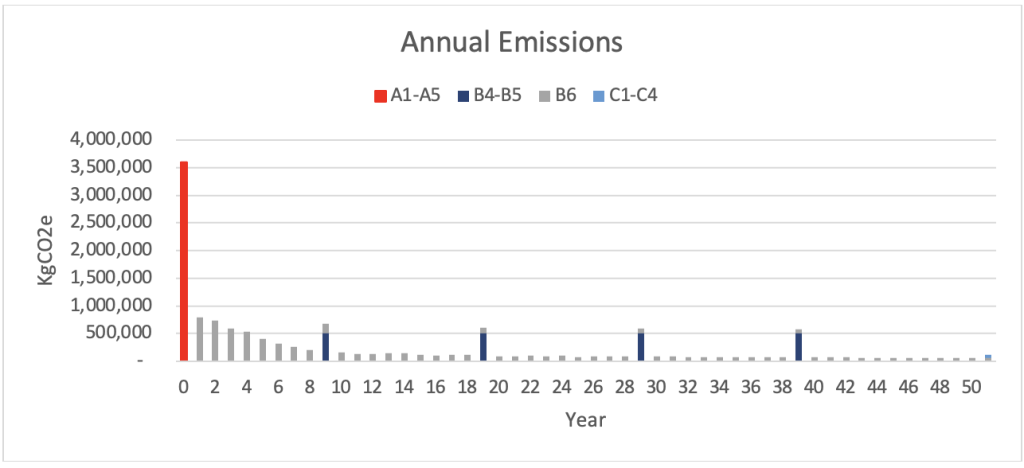
With mandatory carbon assessments on the horizon, STEPHEN BARRETT, Whole Life Carbon Lead, Irish Green Building Council, outlines how the construction sector should approach addressing whole life carbon assessment in a consistent manner.
The recasting of the Energy Performance of Buildings Directive (EPBD) has just received the support of the European Parliament in a plenary vote on 14 March. This means that the mandatory requirement for whole life carbon assessments (WLCAs) of buildings just took another step closer to becoming a reality. Many investors already require WLCAs to provide evidence of green investments in line with the EU Taxonomy and for access to better funding terms.
Regulations on WLCA are already in place in some countries and cities – Denmark, the Netherlands, France and London – and are being progressed in others, such as Finland, Sweden and Norway.
Research carried out by UCD found that the built environment is responsible for 37% of Ireland’s annual emissions – 23% from operating buildings and 14% from materials manufacture. BER assessments help us consider and reduce energy use in buildings, which is useful but not if the reduction is achieved by shifting the emissions from the operational stage of the building’s lifecycle to the production stage by requiring more materials to be manufactured, which is arguably worse as it increases emissions in production plants to reduce them in buildings later.
Whole life carbon assessment
This is an important point, as we need to halve our total emissions in this decade in order to have a chance of staying under the target of a 1.5-degree increase.
WLCA looks at emissions from the beginning of a building’s lifetime right through to the end and beyond. It quantifies the emissions from the mining, processing and transporting of material used in a building – embodied carbon; emissions from energy used over the building’s lifetime – operational carbon; and the usefulness the materials may have in the future when the building is decommissioned – its ‘circularity’.
Currently, in Ireland, there are no building regulations aimed at reducing embodied carbon, and, where WLCA is being carried out, it is not being done in a consistent way. This means results from any two assessments are not comparable since they may be based on differing parameters and assumptions on things like the electricity grid’s carbon intensity in the future or the amount of greenhouse gases emitted in producing certain materials.
We need a standard WLCA methodology so all our building designs, both new-build and renovation, are comparable from a carbon perspective. This will allow us to make better design decisions, draw conclusions fairly and decide what does and does not get built.
Upfrontco2 – A Methodology for Ireland
There is a growing interest in embodied carbon at all levels, including among investors and legislators. The Irish government recognises the need to address whole-life carbon consistently and has made provisions to do this in the Climate Action Plan (CAP).
Action 13.4 in the 2023 CAP and Action 198 in the 2021 CAP highlight the need for a national methodology to calculate the emissions from Irish buildings at each stage in their lifecycle.
With funding from the SEAI, the Irish Green Building Council (IGBC) launched the UpfrontC02 Project in order to develop and test this national methodology. The methodology we developed is based on the European Standard EN 15978 and indicator 1.2 of the EU Level(s) framework for measuring the sustainability of buildings. This is the same framework and indicator used for EU Taxonomy investment decisions and underpinning the EPBD recast mentioned above.
A consistent methodology allows for a fairer comparison of buildings in Ireland and across the EU.
So far, our project partners include the Land Development Agency (LDA), the Health & Safety Executive (HSE), the Department of Education, Dublin City Council, and numerous architects and developers – who are currently applying the methodology to real-world projects in order to understand the impacts of their tenders and designs and how they might mitigate them. They are also learning about how a significant requirement like this will fit into their workflows and feed back ideas and suggestions.
The methodology is evolving as we learn and will be offered back to the Sustainable Energy Authority of Ireland (SEAI) with the recommendation that it be the single methodology for quantifying the WLC of all building projects – thus ensuring fairness and comparability of all building plans.
A ‘typical’ building example
The schematic below shows the annual emissions from a notional new 5,000 sq m building modelled using the IGBC methodology. The high emissions in red in year zero represent the emissions incurred in the production of materials and the construction process in that year – the upfront embodied carbon. The annual emissions in grey represent day-to-day electricity from a decarbonising grid as forecast by the SEAI, and the figures in blue show likely renovation and refurbishment emissions during the building’s lifetime (lifetime embodied carbon).
While we have regulations around operational energy and, therefore, carbon, there are currently no regulations that address the carbon intensity of the production of materials and components. This means the most carbon-intensive year of a typical building’s lifetime – year 0 – has no carbon regulation around it at all.
Historically, operational emissions of buildings were the most significant contributor to global warming, but as we build higher performing, more insulated buildings, this has reduced, and the demand for materials has increased, meaning the emissions from the production of materials for a building is now roughly the same as that of operating that building for 50 years – in short, both have to be considered to produce the lowest possible carbon intensity of a building over its lifetime.
How does the whole life carbon assessment methodology work?
To minimise a building’s impact, we need data on its likely carbon footprint over its whole life, and we need this as early as possible to guide how it will be designed and built. This kind of data is challenging to create as decisions on how to build have not been taken yet, and manufacturing processes vary greatly across materials and manufacturers.
To help with this, the methodology provides generic average data – like a rate card for cost estimation, only providing carbon instead of price figures. In the same way as a cost analysis can be done for different design approaches, this can be used for a carbon analysis, at least for Stage A of the building’s lifetime. We can apply the SEAI’s forecast carbon intensity of the energy grid to understand the balance between this upfront embodied carbon and the emissions from Stage B – the use phase of the building’s life. It helps us optimise our design decisions from a carbon perspective, considering both the quantity of emissions and their timing.
We need case studies to understand our current position and plan for the future. Current case studies are hard to compare with one another as they are assessed using different methodologies. We need a set of consistently assessed case studies so we can better understand the carbon intensity of our different building typologies today. This will help us to:
– Identify our most impactful decisions – the carbon hotspots
– Rethink them in the light of a need to reduce emissions
– Measure the differences we can make
– Design out waste
– Design in circularity
The volunteer partners in the UpfrontCO2 project are currently;
– Learning about the future of EU legislation
– Learning about the balance between Operational and Embodied Carbon
– Learning how to use the WLC calculation methodology
– Discussing problems and sharing their results as they learn
– Understanding how they can embed this process in their workflows
We are starting to see case studies completed using the methodology with plausible results, but we want to see many more; We need to make a concerted effort where all actors in the industry get involved, contribute and learn because legislation in this area is coming.
Become a volunteer partner
The IGBC can supply the methodology, but it is up to the teams themselves to implement it. The benefits of this are:
- Gaining an understanding of the methodology, which will be a requirement in some form in the future
- Influencing the development of the methodology – it is a prototype, and we are trying to understand how best to include this vital aspect of building design into current working patterns
- Reduce the emissions from your building designs – understanding the hotspots is the first step in understanding where to focus your attention. The earlier this is done, the greater the difference you can make as the design evolves.
It is not too late to get involved and join us. Through Construct Innovate, Ireland’s new national centre for construction research, we are calling for more case studies to support and verify the initial findings of UpfrontCO2. This new project, called INDICATE, has been set up to find 50 more case studies across all typologies to build a picture of the whole life carbon of the industry in Ireland today. Cases do not have to be low energy or particularly green – we want to understand what is our business as usual today so we can all learn and improve. This will only work if we collaborate and share our learning. This is an opportunity to upskill for free, with national and European experts on hand to guide and advise on the methodology and provide guidance on possible design ideas that may help us all move in the right direction.
If you have a project in development or one recently finished and you are curious about how it could be optimised to reduce its carbon footprint, please get in touch – email stephen@igbc.ie. He will share the methodology and welcome you to the team.
Stephen Barrett is the Whole Life Carbon Lead at the Irish Green Building Council. He is managing the UPFRONTCO2 project to establish the methodology for WLCA in Ireland and the INDICATE project to test and verify results across a greater sample of case studies.
ABOUT #BUILDINGLIFE
The Roadmap to decarbonise Ireland’s built environment will be launched on 07 October. It has been developed as part of the #BuildingLife campaign. The campaign aims to achieve the mix of private sector action and public policy necessary to tackle the whole-life environmental impact of buildings. The #BuildingLife campaign is funded by the IKEA and Laudes Foundations.
For further information on the Roadmap, the carbon modelling report commissioned to UCD, the Carbon Designer Tool or the EPD Ireland programme, visit www.igbc.ie/lca/










